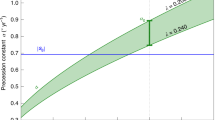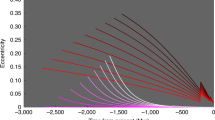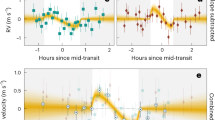Abstract
Two mutually exclusive hypotheses concerning the origin of the martian satellites have commonly been proposed: (1) they were formed in the vicinity of Mars, on orbits not very different from their present orbits, or (2) they originated far from Mars and were somehow captured1–3. Hypothesis (1) had been favoured because the satellites' orbits are nearly circular and equatorial. More recent Viking results imply that the satellites are composed of carbonaceous material4,5, suggesting an asteroidal origin. We show here that the satellites have remained close to their laplacian plane throughout their orbital evolution. Thus Phobos and Deimos need not have originated near the martian equator as previously believed3, but could have been captured in Mars' orbital plane instead, and later evolved to their present inclinations. This new result seems to make hypothesis (2) more plausible.
This is a preview of subscription content, access via your institution
Access options
Subscribe to this journal
Receive 51 print issues and online access
$199.00 per year
only $3.90 per issue
Buy this article
- Purchase on Springer Link
- Instant access to full article PDF
Prices may be subject to local taxes which are calculated during checkout
Similar content being viewed by others
References
Hunten, D. H. Icarus 37, 113–123 (1979).
Pollack, J. B., Burns, J. A. & Tauber, M. E. Icarus 37, 587–611 (1979).
Lambeck, K. J. geophys. Res. 84, 5651–5658 (1979).
Veverka, J. Vistas Astr. 22, 163–192 (1978).
Duxbury, T. C. & Veverka, J. Science 201, 812–814 (1978).
Shor, V. A. Celest. Mech. 12, 61–75 (1975).
Sinclair, A. T. Vistas Astr. 22, 133–140 (1978).
Burns, J. A. Vistas Astr. 22, 193–210 (1978).
Laplace, P. Celestial Mechanics (Reprinted by Chelsea, New York, 1966).
Tisserand, F. Traité de Mecanique Celeste, Vol. II (Gauthiers-Villars, Paris, 1889).
Goldreich, P. Rev. Geophys. 4, 411–439 (1966).
Mignard, F. Celest. Mech. 18, 287–294 (1978).
Ward, W. R. J. geophys. Res. 79, 3375–3386 (1974).
Author information
Authors and Affiliations
Rights and permissions
About this article
Cite this article
Cazenave, A., Dobrovolskis, A. & Lago, B. Evolution of the inclination of Phobos. Nature 284, 430–431 (1980). https://doi.org/10.1038/284430a0
Received:
Accepted:
Issue Date:
DOI: https://doi.org/10.1038/284430a0
Comments
By submitting a comment you agree to abide by our Terms and Community Guidelines. If you find something abusive or that does not comply with our terms or guidelines please flag it as inappropriate.



